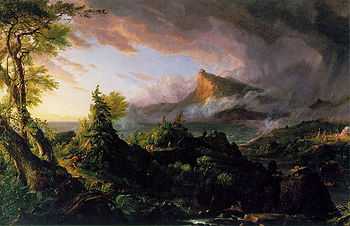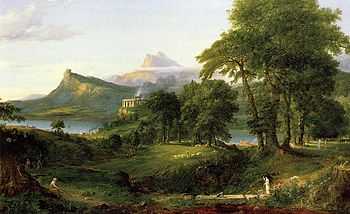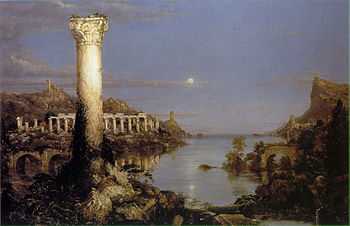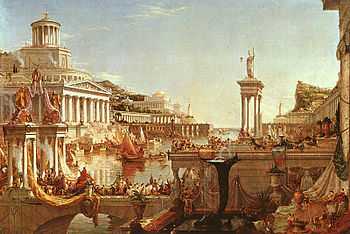The Course of Empire
The Course of Empire is a five-part series of paintings created by Thomas Cole in the years 1833–36. It is notable in part for reflecting popular American sentiments of the times, when many saw pastoralism as the ideal phase of human civilization, fearing that empire would lead to gluttony and inevitable decay. The theme of cycles is also one that Cole returned to frequently, such as in his The Voyage of Life series.
The series was acquired by The New-York Historical Society in 1858 as a gift of the New-York Gallery of Fine Arts,[1] and comprises the following works: The Course of Empire – The Savage State; The Course of Empire – The Arcadian or Pastoral State; The Course of Empire – The Consummation of Empire; The Course of Empire – Destruction; and The Course of Empire – Desolation.
The series of paintings depicts the growth and fall of an imaginary city, situated on the lower end of a river valley, near its meeting with a bay of the sea. The valley is distinctly identifiable in each of the paintings, in part because of an unusual landmark: a large boulder is precariously situated atop a crag overlooking the valley. Some critics believe this is meant to contrast the immutability of the earth with the transience of man.
A direct source of literary inspiration for The Course of Empire paintings is Byron's Childe Harold's Pilgrimage (1812–18). Cole quoted this verse, from Canto IV, in his newspaper advertisements for the series:[2]
There is the moral of all human tales;
'Tis but the same rehearsal of the past.
First freedom and then Glory – when that fails,
Wealth, vice, corruption – barbarism at last.
And History, with all her volumes vast,
Hath but one page...
The paintings are currently on display at the New-York Historical Society.
The Course of Empire
The Savage State

The first painting, The Savage State, shows the valley from the shore opposite the crag, in the dim light of a dawning stormy day. A hunter clad in skins hastens through the wilderness, pursuing a deer; canoes paddle up the river; on the far shore can be seen a clearing with a cluster of wigwams around a fire, the nucleus of the city that is to be. The visual references are those of Native American life. This painting symbolizes the ideal state of the natural world. It is a healthy world, unchanged by mankind.
The Arcadian or Pastoral State

In the second painting, The Arcadian or Pastoral State, the sky has cleared and we are in the fresh morning of a day in spring or summer. The viewpoint has shifted further down the river, as the crag with the boulder is now on the left-hand side of the painting; a forked peak can be seen in the distance beyond it. Much of the wilderness has given way to settled lands, with plowed fields and lawns visible. Various activities go on in the background: plowing, boat-building, herding sheep, dancing; in the foreground, an old man sketches what may be a geometrical problem with a stick. On a bluff on the near side of the river, a megalithic temple has been built, and smoke (presumably from sacrifices) arises from it. The images reflect an idealized, pre-urban ancient Greece. This work shows mankind at peace with nature. It symbolizes that the environment has been altered, but not so much so that the it or its inhabitants are in danger.
The Consummation of Empire
The third painting, The Consummation of Empire, shifts the viewpoint to the opposite shore, approximately the site of the clearing in the first painting. It is noontide of a glorious summer day. Both sides of the river valley are now covered in colonnaded marble structures, whose steps run down into the water. The megalithic temple seems to have been transformed into a huge domed structure dominating the river-bank. The mouth of the river is guarded by two pharoses, and ships with lateen sails go out to the sea beyond. A joyous crowd throngs the balconies and terraces as a scarlet-robed king or victorious general crosses a bridge connecting the two sides of the river in a triumphal procession. In the foreground an elaborate fountain gushes. The overall look suggests the height of ancient Rome. The decadence seen in every detail of this cityscape foreshadows the inevitable fall of this mighty civilization.
Destruction

The fourth painting, Destruction, has almost the same perspective as the third, though the artist has stepped back a bit to allow a wider scene of the action, and moved almost to the center of the river. The action is the sack and destruction of the city, in the course of a tempest seen in the distance. It seems that a fleet of enemy warriors has overthrown the city's defenses, sailed up the river, and is busily firing the city and killing and raping its inhabitants. The bridge across which the triumphal procession had crossed is broken; a makeshift crossing strains under the weight of soldiers and refugees. Columns are broken, fire breaks from the upper floors of a palace on the river bank. In the foreground a statue of some venerable hero (posed like the Borghese Warrior) stands headless, still striding forward into the uncertain future. {the artist name and date 1836 can just be seen on the base of the statue} In the waning light of late afternoon, the dead lie where they fell, in fountains and atop the monuments built to celebrate the affluence of the now fallen civilization. The scene is perhaps suggested by the Vandal sack of Rome in 455.
Desolation

The fifth painting, Desolation, shows the results, years later. We view the remains of the city in the livid light of a dying day. The landscape has begun to return to wilderness, and no human beings are to be seen; but the remnants of their architecture emerge from beneath a mantle of trees, ivy, and other overgrowth. The broken stumps of the pharoses loom in the background. The arches of the shattered bridge, and the columns of the temple are still visible; a single column looms in the foreground, now a nesting place for birds. The sunrise of the first painting is mirrored here by a moonrise, a pale light reflecting in the ruin-choked river while the standing pillar reflects the last rays of sunset. This gloomy picture symbolizes like what all empires could be after their fall. It is a harsh possible future in which humanity has been destroyed by its own hands.
See also
References
- Powell, Earl A. (1990). Thomas Cole. New York: Harry N. Abrams.
- Miller, Angela (1993). The Empire of the Eye: Landscape Representation and American Cultural Politics, 1825–1875. Ithaca, N.Y: Cornell University Press.
- Noble, Lous Legrand (1853). The Life and Works of Thomas Cole. Black Dome Press.
- ↑ New-York Historical Society eMuseum
- ↑ Wilton, Andrew and Barringer, Tim. American Sublime, Landscape Painting in the United States 1820–1880, Princeton University Press, 2002.
- ↑ "The Course of Empire: The Savage State". ExploreThomasCole. Retrieved 20 March 2011.
- ↑ "The Course of Empire: The Arcadian or Pastoral State". ExploreThomasCole. Retrieved 20 March 2011.
- ↑ "The Course of Empire: The Consummation of Empire". ExploreThomasCole. Retrieved 20 March 2011.
- ↑ "The Paintings". Beyond the Notes: The Course of Empire. Retrieved 23 October 2014.
- ↑ "The Course of Empire: Destruction". ExploreThomasCole. Retrieved 20 March 2011.
- ↑ "The Course of Empire: Desolation". ExploreThomasCole. Retrieved 20 March 2011.
